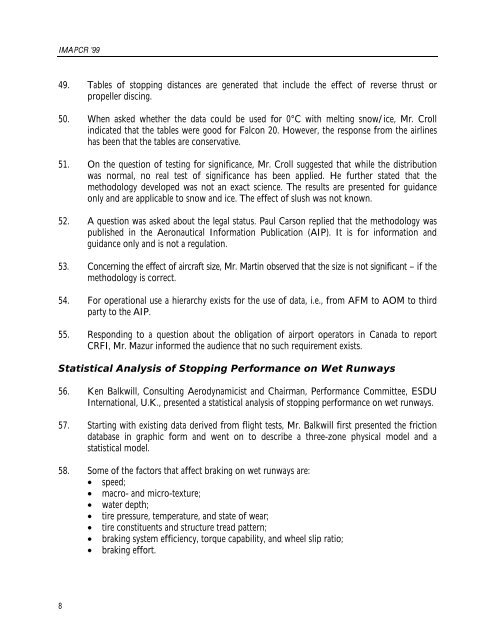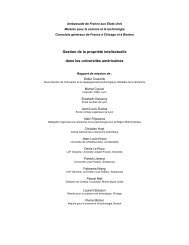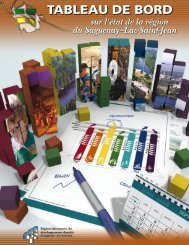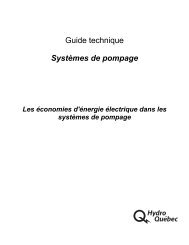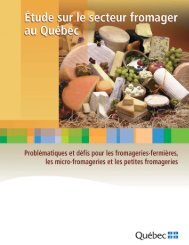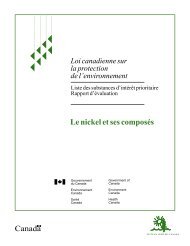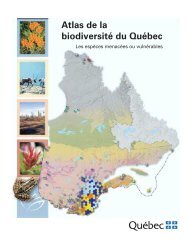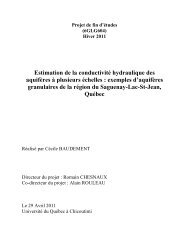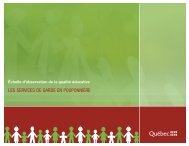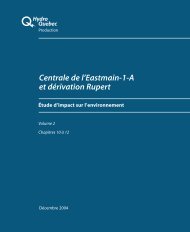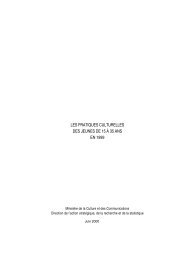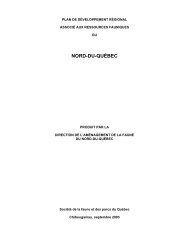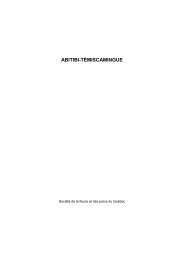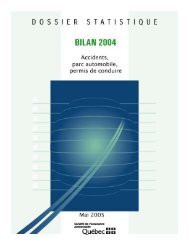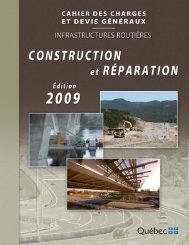- Page 1: TP 13579 PROCEEDINGS of the 2nd Int
- Page 4 and 5: The opinions expressed reflect the
- Page 6 and 7: Transports Canada Transport Canada
- Page 8 and 9: ACKNOWLEDGEMENTS IMAPCR ’99 was m
- Page 10 and 11: JAR JAROPS JBI JWRFMP LD LRPC MFL M
- Page 12 and 13: JAA JAR JAROPS JBI LD LRPC MDN MFL
- Page 14 and 15: PRESENTATIONS AND PAPERS/PRÉSENTAT
- Page 17 and 18: SESSION 1 - OPENING PLENARY SESSION
- Page 19 and 20: IMAPCR ’99 SESSION 2 - SUMMARY OF
- Page 21 and 22: IMAPCR ’99 Comparison of Aircraft
- Page 23: IMAPCR ’99 Predicting Aircraft St
- Page 27 and 28: IMAPCR ’99 Takeoff and Landing on
- Page 29 and 30: IMAPCR ’99 85. Mr. Giesberts conc
- Page 31 and 32: IMAPCR ’99 107. When asked whethe
- Page 33 and 34: IMAPCR ’99 Safety Oversight - ICA
- Page 35 and 36: IMAPCR ’99 International Runway F
- Page 37 and 38: IMAPCR ’99 reported to the pilot.
- Page 39 and 40: IMAPCR ’99 171. When asked whethe
- Page 41 and 42: IMAPCR ’99 SESSION 5 - FUTURE OF
- Page 43 and 44: IMAPCR ’99 plan based on a dialog
- Page 45 and 46: IMAPCR ’99 using wet calculations
- Page 47 and 48: SÉANCE 1 - SÉANCE PLÉNIÈRE D’
- Page 49 and 50: IMAPCR ’99 appareils de mesure du
- Page 51 and 52: IMAPCR ’99 Essais de performance
- Page 53 and 54: IMAPCR ’99 travail sur l’harmon
- Page 55 and 56: IMAPCR ’99 49. Il existe des tabl
- Page 57 and 58: IMAPCR ’99 • le coefficient de
- Page 59 and 60: IMAPCR ’99 • les données ESDU
- Page 61 and 62: IMAPCR ’99 90. Selon un participa
- Page 63 and 64: IMAPCR ’99 Que savons-nous sur la
- Page 65 and 66: IMAPCR ’99 Les documents de l’O
- Page 67 and 68: IMAPCR ’99 135. En conclusion, M.
- Page 69 and 70: IMAPCR ’99 compter la possibilit
- Page 71 and 72: IMAPCR ’99 167. À l’heure actu
- Page 73 and 74: IMAPCR ’99 181. M. Meyer déclare
- Page 75 and 76:
IMAPCR ’99 192. Terry Lutz lance
- Page 77 and 78:
IMAPCR ’99 des opérations. Les r
- Page 79 and 80:
IMAPCR ’99 216. Al Mazur informe
- Page 81 and 82:
PARTICIPANTS Allen, Carl American A
- Page 83 and 84:
Participants Clairoux, Richard Bomb
- Page 85 and 86:
Participants Giesman, Paul Boeing C
- Page 87 and 88:
Participants Landry, Yvon Transport
- Page 89 and 90:
Participants Olsen, Richardt Civil
- Page 91 and 92:
Participants Sinha, Nirmal Institut
- Page 93 and 94:
Welcome Art Laflamme Transport Cana
- Page 95:
Management of the Joint Winter Runw
- Page 98 and 99:
Management of the Joint Winter Runw
- Page 100 and 101:
Management of the Joint Winter Runw
- Page 102 and 103:
Management of the Joint Winter Runw
- Page 105 and 106:
Review of Agenda and Objectives Joh
- Page 107:
Braking Performance of the NASA Boe
- Page 110 and 111:
Braking Performance of the NASA Boe
- Page 112 and 113:
Braking Performance of the NASA Boe
- Page 114 and 115:
Braking Performance of the NASA Boe
- Page 117 and 118:
NRC Falcon 20 Braking Performance o
- Page 119 and 120:
NRC Falcon 20 Braking Performance o
- Page 121 and 122:
NRC Falcon 20 Braking Performance o
- Page 123 and 124:
NRC Falcon 20 Braking Performance o
- Page 125 and 126:
NRC Falcon 20 Braking Performance o
- Page 127 and 128:
NRC Falcon 20 Braking Performance o
- Page 129 and 130:
NRC Falcon 20 Braking Performance o
- Page 131 and 132:
NRC Falcon 20 Braking Performance o
- Page 133:
NRC Falcon 20 Braking Performance o
- Page 137 and 138:
Dash 8 Aircraft Performance Testing
- Page 139 and 140:
Dash 8 Aircraft Performance Testing
- Page 141 and 142:
Dash 8 Aircraft Performance Testing
- Page 143:
Comparison of Aircraft Braking Perf
- Page 146 and 147:
Comparison of Aircraft Braking Perf
- Page 148 and 149:
Comparison of Aircraft Braking Perf
- Page 150 and 151:
Comparison of Aircraft Braking Perf
- Page 153:
Aircraft Takeoff Performance on Con
- Page 156 and 157:
Aircraft Takeoff Performance on Con
- Page 158 and 159:
Aircraft Takeoff Performance on Con
- Page 160 and 161:
Aircraft Takeoff Performance on Con
- Page 162 and 163:
Aircraft Takeoff Performance on Con
- Page 164 and 165:
Aircraft Takeoff Performance on Con
- Page 166 and 167:
Aircraft Takeoff Performance on Con
- Page 168 and 169:
Aircraft Takeoff Performance on Con
- Page 171:
Operations on Contaminated Runways
- Page 174 and 175:
Operations on Contaminated Runways
- Page 176 and 177:
Operations on Contaminated Runways
- Page 179:
Determination of Aircraft Landing D
- Page 182 and 183:
Determination of Aircraft Landing D
- Page 184 and 185:
Determination of Aircraft Landing D
- Page 186 and 187:
Determination of Aircraft Landing D
- Page 188 and 189:
Determination of Aircraft Landing D
- Page 190 and 191:
Determination of Aircraft Landing D
- Page 192 and 193:
Determination of Aircraft Landing D
- Page 194 and 195:
Determination of Aircraft Landing D
- Page 197:
Statistical Analysis of Stopping Pe
- Page 200 and 201:
Statistical Analysis of Stopping Pe
- Page 202 and 203:
Statistical Analysis of Stopping Pe
- Page 204 and 205:
Statistical Analysis of Stopping Pe
- Page 206 and 207:
Statistical Analysis of Stopping Pe
- Page 208 and 209:
Statistical Analysis of Stopping Pe
- Page 210 and 211:
Statistical Analysis of Stopping Pe
- Page 212 and 213:
Statistical Analysis of Stopping Pe
- Page 215 and 216:
Summary of Falcon 20 Contamination
- Page 217 and 218:
Summary of Falcon 20 Contamination
- Page 219 and 220:
Summary of Falcon 20 Contamination
- Page 221 and 222:
Summary of Falcon 20 Contamination
- Page 223 and 224:
Summary of Falcon 20 Contamination
- Page 225:
Takeoff and Landing on Runways Cont
- Page 228 and 229:
Takeoff and Landing on Runways Cont
- Page 230 and 231:
Takeoff and Landing on Runways Cont
- Page 232 and 233:
Takeoff and Landing on Runways Cont
- Page 234 and 235:
Takeoff and Landing on Runways Cont
- Page 237 and 238:
Contamrunway Snow Tests CONTAMRUNWA
- Page 239 and 240:
Contamrunway Snow Tests Main Activi
- Page 241 and 242:
Contamrunway Snow Tests Snow Types
- Page 243 and 244:
Contamrunway Snow Tests Snow Test S
- Page 245 and 246:
Contamrunway Snow Tests Snow/Slush
- Page 247 and 248:
Contamrunway Snow Tests Citation II
- Page 249 and 250:
Contamrunway Snow Tests Conclusions
- Page 251:
A Model for Predicting Rolling Resi
- Page 254 and 255:
A Model for Predicting Rolling Resi
- Page 256 and 257:
A Model for Predicting Rolling Resi
- Page 258 and 259:
A Model for Predicting Rolling Resi
- Page 260 and 261:
A Model for Predicting Rolling Resi
- Page 262 and 263:
A Model for Predicting Rolling Resi
- Page 265 and 266:
A Model for Predicting Rolling Resi
- Page 267 and 268:
A Model for Predicting Rolling Resi
- Page 269 and 270:
A Model for Predicting Rolling Resi
- Page 271:
A Model for Predicting Rolling Resi
- Page 275 and 276:
Hydroplaning of Modern Aircraft Tir
- Page 277 and 278:
Hydroplaning of Modern Aircraft Tir
- Page 279:
Hydroplaning of Modern Aircraft Tir
- Page 282 and 283:
Hydroplaning of Modern Aircraft Tir
- Page 284 and 285:
Hydroplaning of Modern Aircraft Tir
- Page 287:
What Do We Know about Snow and Ice?
- Page 290 and 291:
What Do We Know about Snow and Ice?
- Page 292 and 293:
What Do We Know about Snow and Ice?
- Page 294 and 295:
What Do We Know about Snow and Ice?
- Page 296 and 297:
What Do We Know about Snow and Ice?
- Page 298 and 299:
What Do We Know about Snow and Ice?
- Page 300 and 301:
What Do We Know about Snow and Ice?
- Page 303 and 304:
JAR Regulations on Contaminated Run
- Page 305 and 306:
JAR Regulations on Contaminated Run
- Page 307 and 308:
JAR Regulations on Contaminated Run
- Page 309 and 310:
JAR Regulations on Contaminated Run
- Page 311:
Safety Oversight - ICAO Documents A
- Page 314 and 315:
Safety Oversight - ICAO Documents S
- Page 316 and 317:
Safety Oversight - ICAO Documents E
- Page 318 and 319:
Safety Oversight - ICAO Documents r
- Page 320 and 321:
Safety Oversight - ICAO Documents I
- Page 322 and 323:
Safety Oversight - ICAO Documents T
- Page 325:
Statistical Methodology for Interna
- Page 328 and 329:
Statistical Methodology for Interna
- Page 330 and 331:
Statistical Methodology for Interna
- Page 332 and 333:
Statistical Methodology for Interna
- Page 334 and 335:
Statistical Methodology for Interna
- Page 337 and 338:
International Runway Friction Index
- Page 339 and 340:
International Runway Friction Index
- Page 341:
International Runway Friction Index
- Page 345 and 346:
International Runway Friction Index
- Page 347 and 348:
International Runway Friction Index
- Page 349 and 350:
International Runway Friction Index
- Page 351:
Physical Methodology for IRFI Arild
- Page 354 and 355:
Physical Methodology for IRFI Sampl
- Page 356 and 357:
Physical Methodology for IRFI Frict
- Page 358 and 359:
Physical Methodology for IRFI The I
- Page 360 and 361:
Physical Methodology for IRFI Harmo
- Page 362 and 363:
Physical Methodology for IRFI Runwa
- Page 364 and 365:
Physical Methodology for IRFI IRFI
- Page 366 and 367:
Physical Methodology for IRFI Tempe
- Page 368 and 369:
Physical Methodology for IRFI Summa
- Page 371 and 372:
IRFI Reference Device Joint Winter
- Page 373 and 374:
IRFI Reference Device Reference Fri
- Page 375 and 376:
IRFI Reference Device Reference Dev
- Page 377 and 378:
IRFI Reference Device Reference Dev
- Page 379 and 380:
IRFI Reference Device Measurements
- Page 381:
Joint Winter Runway Friction Test P
- Page 384 and 385:
Joint Winter Runway Friction Test P
- Page 386 and 387:
Joint Winter Runway Friction Test P
- Page 388 and 389:
Joint Winter Runway Friction Test P
- Page 391 and 392:
Surface Friction and Index Developm
- Page 393:
Future of Testing Program Thomas J.
- Page 396 and 397:
Future of Testing Program JOINT WIN
- Page 398:
Future of Testing Program FUTURE PL


